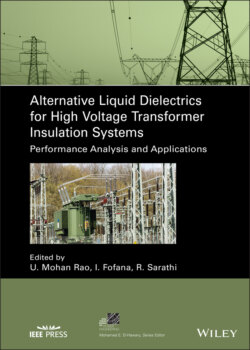Читать книгу Alternative Liquid Dielectrics for High Voltage Transformer Insulation Systems - Группа авторов - Страница 37
2.3.1 Extraction of Oil
ОглавлениеFrom Figure 2.2, it is seen that the biological seeds are collected when they mature. Thereafter, the thick cover on the oil nut is removed by peeling. Once the seeds are peeled off, they are allowed to undergo heat treatment for drying. The drying process is of two types; one is the natural method of drying by exposing the seeds to sun light, and another is the laboratory method using the heating ovens. After that, the treated seeds are dried completely, and removal of dead seeds and solid impurities are carried out through separation technique. Once the separation is over, the seeds are now ready for extraction of crude oil.
Table 2.2 Basic properties of NEO [2,6–8, 13, 21, 26].
Source: Based on Rakesh and Thomas [2]; Wilhelm et al. [6]; Kumar et al. [13]; Maharana et al. [26].
| Properties Oils | Kinematic viscosity at 40 °C (cSt) | Flash point (°C) | Acid value (mg KOH/g) | AC BDV (kV) | Pour point (°C) |
|---|---|---|---|---|---|
| Jatropha oil | 33.8 | 260 | 0.06 | 73 | −3 |
| Crude Pongamia oil | 32 | 250 | 1.3 | 87.5 | −25 |
| Pongamia oil Methyl Ester | 12 | 284 | 0.9 | 82 | −1 |
| Rapeseed oil | 43 | 325 | 0.03 | 73 | −18 |
| Biovolt A (mineraltec) | 36.1 | 312 | 0.05 | 55 | −21 |
| Soya oil | 33.1 | 318 | 0.08 | 42 | −12 |
| Rice oil | 32.4 | 318 | 0.04 | 37 | −15 |
| Sunflower oil | 38 | 312 | 0.06 | 37 | −6 |
| Coconut oil | 25.7 | 298 | 0.005 – 0.05 | 35 | 23 |
| Neem oil | 108.79 | 288 | — | 43 | — |
| Mustard oil | 95.74 | 289 | — | 41.6 | — |
| Punna oil | 129.66 | 280 | — | 42.3 | — |
| Castor oil | 155.71 | 280 | — | 31 | — |
| Palm oil | 5.06 | 186 | 0.005 | 81 | −32.5 |
| Mineral oil | 8.13 | 146 | 0.01 | 35 | −40 |
Figure 2.2 Processing of natural esters from seeds.
